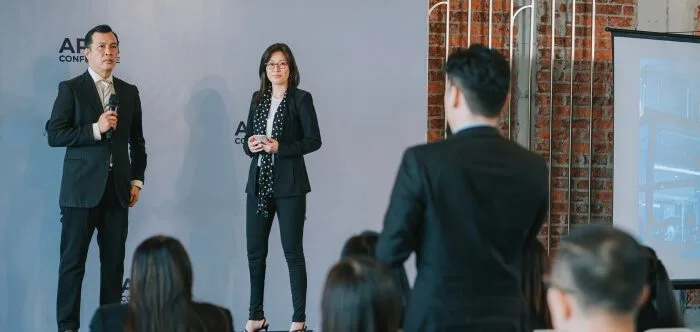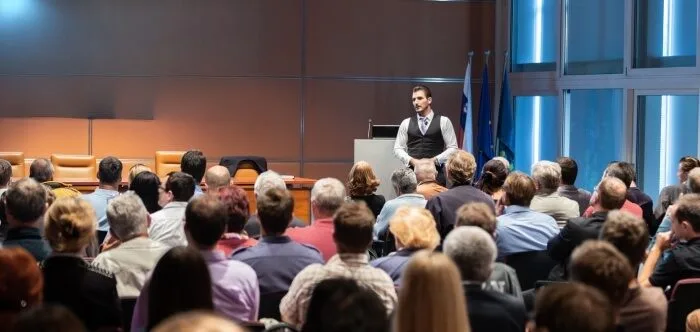Standing out as a memorable event can be challenging in the endless conferences and seminars. That’s why understanding what makes a great conference session, is crucial for organizers and speakers.
A great conference session is more than just a gathering; it’s an engaging blend of a relevant topic, delivered by expert speakers, and made more engaging with interactive elements and effective visual aids. It’s about setting clear objectives, offering networking opportunities, and ensuring the content is accessible to all.
Professional moderation and well-managed timing are key to keeping the session both educational and memorable. For a deeper dive into each of these critical components and how they contribute to the success of a conference session, continue reading our comprehensive blog.
What are Sessions in a Conference?
Conferences are formed of multiple segments known as sessions, each focusing on specific topics or themes. These sessions allow attendees to engage deeply with content that aligns with their professional interests. Typically, each session features presentations, discussions, or workshops. This structure helps participants absorb and discuss information effectively.

Sessions vary in format, including panels, lectures, or interactive workshops, to suit different learning styles. They are often led by experts or thought leaders in the field, providing valuable insights and updates. Participants can choose from a variety of sessions, allowing them to personalize their conference experience. This flexibility ensures that everyone finds something relevant and interesting.
To get the most out of a conference, it’s crucial to participate in an effective conference session. These sessions are carefully planned to maximize engagement and knowledge transfer. Selecting the right sessions can increase your learning and networking opportunities significantly. Overall, attending these sessions can be incredibly beneficial to your professional development.
Core Purpose of Conference Session
Professionals can connect, learn, and advance in their areas on important platforms provided by conferences. At the core of these events are the sessions, where the essence of the conference is truly captured. These sessions are designed with specific goals in mind to maximize the value for attendees.
- Knowledge Sharing: Sessions provide a forum for experts to share their insights and latest research, promoting a culture of continuous learning.
- Networking Opportunities: They offer a unique space for attendees to connect with peers, mentors, and industry leaders, facilitating professional relationships.
- Skill Development: Interactive workshops and seminars within sessions focus on developing practical skills relevant to attendees’ professional growth.
- Trend Analysis: These gatherings are hotspots for discussing current trends and future predictions, keeping professionals abreast of industry changes.
- Problem-Solving Forums: Sessions often involve brainstorming and collaborative problem-solving, addressing common challenges faced in the field.
- Inspiration and Motivation: Hearing from successful figures and engaging in meaningful discussions can inspire and motivate participants in their careers.
- Feedback and Collaboration: They provide a platform for presenting ideas and receiving feedback, encouraging collaboration and refinement of concepts.
Conference sessions are a crucial component of these gatherings, offering a blend of learning, networking, and inspiration. They are the heartbeat of conferences, driving the exchange of ideas and building a sense of community among professionals.
Types of Sessions Maintained in a Conference
Diverse and engaging, the array of session types at a typical conference caters to a wide range of interests and learning styles. From in-depth discussions to practical workshops, each session format is uniquely designed to offer unique value. Here’s a look at the different kinds of sessions you might encounter, enhancing the overall conference experience.
Keynote Sessions
Keynote sessions are often the highlight of a conference, featuring prominent figures or experts. These speakers share insights, inspire with their stories, and set the tone for the event. Keynotes are usually scheduled to draw maximum attendance, often at the beginning or end of the conference. Their talks can influence the overall theme of the conference and spark discussions.
Panel Discussions
Panel discussions bring together a group of experts to discuss a specific topic. These sessions encourage diverse viewpoints, sparking dynamic conversations and debates. Attendees get the chance to hear different perspectives on key issues. Panels often include a Q&A segment, allowing audience interaction and engagement.
Workshops and Seminars
Workshops and seminars focus on skill development and practical knowledge. Led by specialists, they offer hands-on experiences or in-depth coverage of a topic. Attendees can expect to leave with new skills or a deeper understanding. These sessions are ideal for those looking to gain actionable insights.
Breakout Sessions
Breakout sessions are smaller, more focused gatherings within the larger conference. They allow attendees to dive into specific subjects in an intimate setting. These sessions encourage interaction and discussion among a smaller group of participants. Breakout sessions can cover niche topics, offering a tailored experience.
Networking Events
Networking events are less formal and focus on building professional connections. They provide a relaxed environment for attendees to mingle and discuss shared interests. These sessions might include mixers, dinners, or casual meet-ups. Networking events are crucial for building community and collaboration.
Plenary Sessions
Plenary sessions are a central feature of many conferences, bringing all attendees together in one large setting. Understanding plenary sessions in conferences is crucial, as they often feature major speeches or keynotes addressing all participants. These sessions engage a broad audience and highlight relevant topics, making them essential to the event’s unity. High-profile speakers have typically participated in them, and they provide an overview of the conference’s major themes.
Poster Sessions
Poster sessions showcase research and projects in a visual format. Presenters use posters to summarize their work and engage in one-on-one discussions with attendees. This format is common in academic and research-oriented conferences. Poster sessions offer a more personal interaction with the content and its creators.
The variety of sessions in a conference ensures that every attendee finds something valuable and relevant. Whether it’s gaining knowledge, developing skills, or building networks, these sessions are designed to cater to a wide range of interests and needs.
What Makes a Great Conference Session?
A great conference session is an art that blends various elements to engage, educate, and inspire attendees. The magic lies in balancing content, interaction, and presentation to create a memorable experience. Here we explore what makes a great conference session.
Engaging Content
The foundation of a great session is its content, which should be relevant, timely, and intriguing. It must resonate with the audience, addressing current trends or challenges in the industry. Content should be well-researched and presented in a structured manner. This ensures attendees leave feeling informed and enriched.
Expert Speakers
Speakers play a central role in the success of a session. They should not only be experts in their field but also engaging storytellers. Good speakers connect with their audience, making complex topics accessible and interesting. Their ability to convey information effectively can make or break a session.
Interactive Format
Interactive elements keep the audience engaged and involved. This can include Q&A segments, live polls, or group discussions. Interactive sessions make learning a two-way street, enhancing the overall experience. It’s a chance for attendees to be active participants rather than passive listeners.
Visual Aids and Technology
Effective use of visual aids like slides, videos, and infographics can greatly add value to a presentation. Technology should aid in clarifying and emphasizing key points. However, technology must complement, rather than overshadow, the content. Well-designed visuals can make a session more dynamic and memorable.
Clear Objectives and Takeaways
Each session should have defined objectives and provide clear takeaways for the audience. Attendees should understand the session’s purpose and what they’ll gain from it. Clear goals help in keeping the session focused and relevant. This ensures the time spent is valuable and impactful.
Networking Opportunities
Sessions should facilitate networking, allowing attendees to connect with peers and speakers. This can be done through structured networking activities or informal discussions post-session. Networking adds a valuable dimension to the learning experience. It enables the exchange of ideas and helps develop professional relationships.
A great conference session is a blend of substantial content, expert delivery, audience engagement, effective use of technology, clear objectives, and networking opportunities. It’s about creating an environment where learning, interaction, and connection thrive, leaving attendees enriched and inspired.
How to Adapt and Maintain Session Quality in Dynamic Situations?
Adapting and maintaining session quality in dynamic situations is crucial for the success of any event. It requires flexibility, quick thinking, and a proactive approach. Here is the step-by-step guide on how to adapt and maintain session quality in dynamic situations:
Step 1: Anticipate Potential Changes
Expect the unexpected and plan for various scenarios. Whether it’s a last-minute change in speakers or a shift in audience size, being prepared is key. Have backup plans for major components like technology, venue, and personnel. This foresight allows you to adapt quickly without compromising the session’s quality.
Step 2: Stay Informed and Flexible
Keep yourself updated on any factors that could impact your session. This includes staying attuned to the latest industry trends, technological updates, or logistical changes. Flexibility in your approach lets you modify aspects of the session swiftly, ensuring it remains relevant and engaging.
Step 3: Engage with Your Audience
Understand and respond to your audience’s needs and feedback in real-time. Utilize live polls, Q&A sessions, or direct conversations to gauge their interests or concerns. Adjusting content or presentation style based on audience engagement can significantly impact the session’s effectiveness.
Step 4: Utilize Technology Wisely
Embrace technological tools that can help you adapt to changes. From digital platforms for content delivery to apps for audience interaction, technology can be a powerful ally. Ensure you’re familiar with these tools and have backup options in case of technical difficulties.
Step 5: Foster a Collaborative Environment
Encourage collaboration and networking among participants. In dynamic situations, the collective wisdom and experience of the audience can be invaluable. This approach not only enriches the session but also builds a supportive community that can adapt to changes together.
Step 6: Reflect and Rehearse
After each session, take time to reflect on what worked and what didn’t. Gather feedback from participants and team members. Use these insights to continuously improve and be better prepared for future sessions.
Managing the ever-changing area of event sessions demands a blend of preparation, adaptability, and audience engagement. By following these steps, you can ensure that your sessions remain high-quality, relevant, and engaging, regardless of the circumstances.
Tips to Avoid Common Mistakes While Maintaining a Conference Session
Organizing a conference session is a complex task that requires attention to detail and strategic planning. Even experienced organizers can encounter pitfalls along the way. To help streamline this process, here are some tips to avoid common mistakes while maintaining a high-quality conference session.
- Underestimating Time Requirements: Carefully plan the session’s timeline, including presentations and Q&A segments. Avoid overloading the schedule, which can lead to rushed sessions or delays.
- Neglecting Audience Engagement: Keep your audience in mind when planning content and activities. Interactive elements like polls or discussions can maintain interest and participation.
- Overlooking Technical Needs: Ensure all technical requirements, such as audio-visual equipment, are checked and functional. A technical rehearsal before the session can prevent unforeseen issues.
- Ignoring Speaker Preparation: Provide speakers with clear guidelines and expectations. Encourage them to rehearse and be familiar with the session format and technology.
- Forgetting to Facilitate Networking: Allocate time for networking, allowing attendees to connect and discuss. This ontributes to the overall experience and value of the session.
- Overlooking Session Descriptions: Make sure session descriptions are clear and informative. The purpose of a session description for a conference is to provide attendees with enough information to decide on their interests and relevance. Well-crafted descriptions can significantly increase attendee planning and engagement.
- Lacking Contingency Plans: Have backup plans for potential issues, such as speaker cancellations or equipment failure. Flexibility and preparedness are key to handling unforeseen circumstances.
The success of a conference session hinges on precise planning and the ability to anticipate and respond to challenges. By following these tips, organizers can create an engaging, smooth-running session that resonates with their audience.
FAQs About What Makes a Great Conference Session?
When planning or attending a conference, being aware of what elements contribute to a great session is key. Below are some frequently asked questions that explore various aspects of creating and recognizing outstanding conference sessions:
How Important is Speaker Selection for a Conference Session?
Speaker selection is vital, as the speaker’s expertise and delivery can make or break a session. A great speaker not only knows the topic well but also engages the audience effectively. Charismatic and knowledgeable speakers can inspire and educate attendees. Their reputation can also attract a larger audience.
What Role Does Audience Interaction Play in a Great Session?
Maintaining engagement and ensuring the session is relevant depends on audience interaction. Incorporating Q&A segments, polls, or group discussions can make the session more dynamic. Interaction allows participants to clarify doubts, share their views, and feel more involved in the session. It also provides instant feedback for the speaker.
How Important Is Timing in a Conference Session?
Timing is crucial to keep the session on track and respect the audience’s time. Starting and ending on time shows professionalism and ensures audience engagement. Proper timing also allows for adequate coverage of content and interaction without feeling rushed or dragged.
What Is the Ideal Duration for a Conference Session?
The ideal duration depends on the topic and audience but usually ranges from 45 minutes to an hour. This allows enough time to cover the topic in depth while maintaining the audience’s attention. Short sessions can lead to rushed content, while longer ones risk losing engagement.
What are the Benefits of Hosting a Hybrid Conference Session?
Hybrid sessions allow both in-person and virtual attendees to participate, increasing accessibility. They can reach a broader audience and facilitate global connections. This format also provides flexibility for attendees who may not be able to travel. Hybrid sessions can maximize engagement through various interactive tools and platforms.
Bottom Line
The goal of creating a great conference session is to present information engagingly and educationally. Expert speakers, who are skillful at engaging with their audience, play a crucial role in this process.
Central to what makes a great conference session, is the interplay of interactive elements and the strategic use of technology and visual aids. These components work in tandem to create a dynamic and immersive learning environment.
In essence, the success of a conference session is also measured by the clarity of its objectives and the networking opportunities it provides. This blend of education, interaction, and connection forms the cornerstone of a memorable and impactful conference experience.





